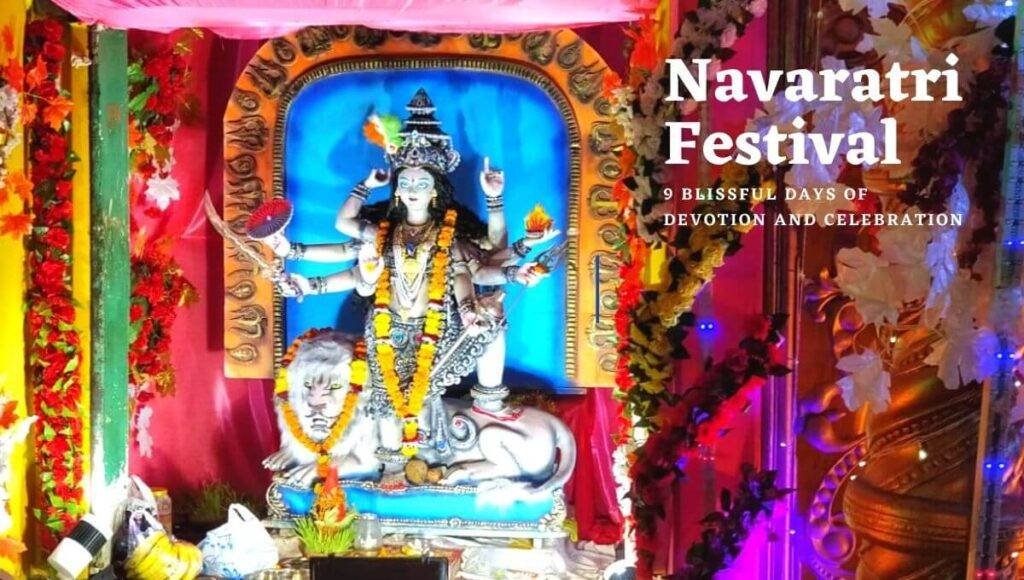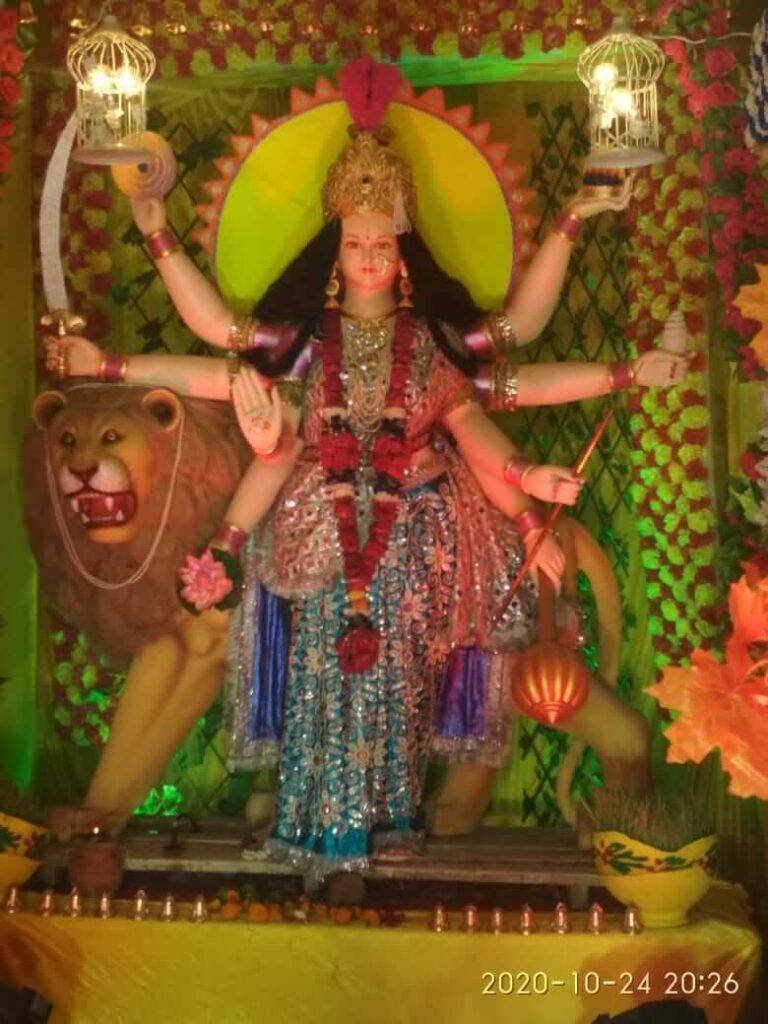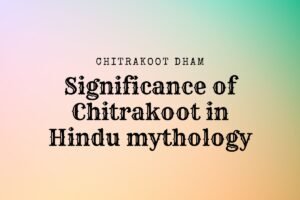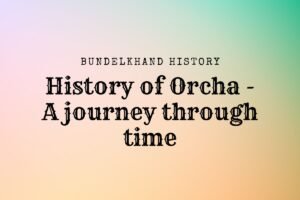Navaratri in Bundelkhand: Navaratri is a Hindu festival that is celebrated in most parts of India. Navaratri spans over 9 days for worshiping 9 goddesses (Navadurga). Navaratri is celebrated with stage decorations, recital of the legend, enacting of the story of Goddess Durga, and chanting of the scriptures of Hinduism.
Navadurga is nine manifestations of the goddess Durga in Hinduism. The nine forms of Goddess Parvati are Shailaputri, Brahmacharini, Chandraghanta, Kushmanda, Skandamata, Katyayani, Kaalratri, Mahagauri, and Siddhidhatri. In Navratri, each day is to worship one form of Goddess Durga.
Maheswari Devi temple Banda- Center of Devotion, spirituality, and positivity
Most of the festivals have their origin in spectacular events of mythology and religious legends of the festival concerned. Navaratri means nine nights in Sanskrit ‘Nava’ means nine and ‘Ratri’ means night. It is one such festival where we celebrate and worship the Goddess Durga in nine different forms. It is a festival to worship females as shakti of the universe.

Mythological significance of Navaratri – Navaratri in Bundelkhand
It is celebrated- for the victory of the goddess Durga over the demon Mahishasura and it is a symbolic victory of lightness over darkness, goodness over evilness. The arrival of the autumn season marks the beginning of this festival; it is called Sharad Navratri or Mahanavaratri. Chaitra Navaratri takes place during the spring season. Sharad Navaratri begins on the first new moon of the early autumn and ends with the celebration of Dussehra on the tenth day.
Reasons to celebrate Navaratri – Navaratri in Bundelkhand
We celebrate the Navaratri for the victory of the good over the evil. In our scriptures, many stories extol the glory of the Devi and her powerful aura. One such scripture is “Devi-Mahatmya” found in Markandeya Purana that recounts the tradition of Navaratri. According to this text, the goddess Durga was called upon by all the three gods- Brahma, Vishnu, and Mahesh to eliminate the buffalo demon Mahishasura and save the earth from his cruel ways.
The battle went on for nine days, and finally, on the tenth day- Goddess Durga decimated him ending the miseries of the world. We celebrate the tenth day as Vijayadashmi or Dussehra. According to one more legend, the goddess Durga was the daughter of the Himalaya and Menka. Then she married lord shiva and became “sati”. It is a belief that the festival of Durga puja began when lord Rama worshipped the goddess Durga and requested her for granting him special powers to counter Ravana.
Indian festivals and their significance
India is a land of festivals. Different types of festivals are celebrated here by all walks of people. Festivals play a prominent role in our lives, as we are living in a fast-paced and digital world; we are regularly under so much pain and stress all the time. Festivals are the time to come out of this stress and express ourselves and create joy and happiness for all. Celebrating festivals brings Joy for all as this is the occasion where all the gatherings took place- friends, relatives, loved ones assemble and share their happiness.
These are the occasion of the family gatherings, exchange of greetings and sweets, joy, praying, fasting, and feasting. People visit temples, holy places, worship gods, and ask their favor. Festivals come round the year and bring joy, color, variety, and spice to life. The festival celebration is in the psyche and blood of the Indians.
Process of Navaratri celebration – Navaratri in Bundelkhand
Navratri celebrations begin with the setting up of an idol of Devi Durga, and devotees request the goddess to come to the earth, and the process is called Mahalaya. There-after consecration “Pran Prathisthaan” of Devi Durga; is done invoking mantras and performing rituals on the day of Saptami. It is a belief that after this, goddess Durga comes in spiritual form in the idol and thus becomes a living entity. During the festival- people offer prayers and worship her in nine different-forms. Some people observe fast for nine days- starting from the first day to please the goddess Durga and purify their soul and mind.
On day eight, after performing puja and aartis, people gathered together to dance in front of the goddess Durga to gratify her. The dance is performed in the musical beats of dhol and nagara while holding a clay pot covered with burning coconut and camphor. On day nine, the maha-aarti performance marks the endings of Major rituals and prayers. On the tenth day, the idol of goddess Durga is taken outside for immersion in a nearby waterbody. It is a custom among married women to mark themselves with the red vermillion offered to the goddess Durga and seek her blessings.
Celebration of Navratri in different regions of India
The beautiful thing about Navratri is that not everywhere Navratri is celebrated in the same way. Celebrations occur according to the local practices and rituals of that area. Celebrations differ based on the customs, place, and beliefs of the people. Things differ to such an extent that somewhere it is celebrated for only five days, somewhere it is for seven days, and somewhere it is for ten days.
Importance of Navaratri Celebration
Navaratri brings joy and hope for Bundelkhand. It is time where farmers start plowing and sowing seeds in their fields. The arrival of autumn fills the air with the fragrance of freshness. There is a tinge of devotion in the atmosphere with the onset of Navaratri. Devotees observe fast for nine days to please the Devi. There is a customary practice for women in Bundelkhand to hold fast and to sow seeds of grains in the pot on the first day, which they keep at the places of worship and in temples. With each passing day, grains started to grow and filled the pot with saplings of grain.

On day nine, all the Pots are taken out and immersed in nearby ponds, lakes, and rivers. People in cities set up a pandal to worship the Devi and visit these pandals during the night to offer prayers. Various profound and talented stage artists enact the scenes from the Ramayana, popularly known as Ramleela, and people watch these stage performances with great devotion and enthusiasm. Ramleela is very famous, especially the Van Gaman, Bharat Milaap, Sita Haran, and Lanka Dahan are special moments and enjoyed by all walks of people.
On the tenth day, the effigies of Ravana and Kumbhakaran set to fire to mark the victory of Lord Rama over Ravana. In the meantime, the large processions of devotees carrying an idol of goddess Durga- are taken out for immersion in the river. During the yatra – devotees dance and sing in the tunes of devotional music, play with color, enjoy, and bid farewell to their revered goddess Durga in the hope of coming again next year.
Navaratri celebrations in Westbengal
The last five days of Navaratri- is celebrated as Durga Puja in West Bengal, and reveled with much joy and delight. It is honored by establishing a pandal of goddess Durga near their homes and offering prayers and performing rituals. The goddess Durga is shown- with different weapons in her hand riding over the roaring lion. The Eighth Day is celebrated- as Durga- Ashtami, and this has much significance in celebration.
The beautifully decorated idol of Devi Durga is set up in temples and pandals. Dance and cultural programs take place, and people enjoy singing and dancing. Traditional food is prepared to savor the moment. The streets of Kolkata are abuzz with different kinds of food stuff. The local junta and foreigners feast on the delicious food offered in the local food stalls and shop, including sweets. During Durga puja, all the public workplaces are closed for an entire week for celebrations.
Navaratri celebration in Gujarat
Gujaratis celebrate Navaratri in their unique way by dancing to the tune of Garba and Dandiya. Garba is an exquisite form of dance performed by women in circles around a pot containing a lamp. The word Garba or ‘Garbha’ means a womb, and in this context, the Diya inside a pot signifies life within a womb. Besides this, Men and women perform the Dandiya dance in circle-holding their colored sticks, having tied with ghunguroo at the end of the cane.
Dancing in a circle and moving sideways, men and women- strike the sticks of their partner and as well as their own- forming a beautiful pattern of dancing with the jingling sound of ghunguroos.
Durga puja in south India
Ayudh puja is performed- with much enthusiasm and jubilation on day nine. All the automobiles, machinery, tools, pieces of equipment, and agriculture implements are decorated and worshipped on this day. Vijaydashmi- is observed on the last day. For some parts of south India, it is a day where people send their kids for learning, and it is auspicious to begin the quest for knowledge on this day. In the city of Mysore, this day is rejoiced by taking grand processions on the streets by carrying the goddess Chamundi.
Navaratri celebrations in north India
In north India, Navratri is honored by holding fasts and worshipping Goddess Durga for nine days. The tenth day revels in the memory of the victory of Lord Rama over Ravana. It was the day when Lord Rama killed the Ravana in a fierce battle with him. This day is for the triumph of truth over evil. Effigies of the Ravana and Kumbhkaran- stuffed with crackers and fireworks- are burnt to celebrate the victory of good over evil.
In some places, there is a practice of sacrificing the animals to please the goddess Durga. In other areas, people observe strict fasting and go to the temples by laying down their whole body in a forward direction to propitiate the Devi. Call it a superstition or devotion, but it is a customary practice; the people have been following it for a very long time now as it sets the tone of the festival for them.
My personal experiences of Navaratri celebration – Navaratri in Bundelkhand
Navaratri is such a beautiful festival that it always brings up my childhood memories. It was such a joy and delightful moments were those. Coming from a village background and then settling into the district for further studies, it was a very different scene for me altogether. We used to have pandals of Devi at many locations of the city. There were pandals of the Devi’s at prominent points of the locality, and devotees used to visit and seek blessings of the Devi along with delicious prasad. Although, all the pandals were equally important.
There were some particular places inside the city- which were more famous for their idol of Devi. Those idols of Devi were larger, brighter, well decked up with different kinds of jewels and ornaments. The magnificence and grandeur of these idols were the talks of the town, and people would get ready to visit these places and witness the magic of the Devis. I, along with my close friends, used to go for darshan of these Devis. We would start from the nearest Devi, then one by one we would go and visit all the Devis of the city.
We all used to go on foot for Devi darshan, and After covering all the prominent points of Devi darshan, we used to come home exhausted and then dozed off. The mere thought of going with friends the next day for Devi darshan used to take away all our body aches and tiredness. It used to be so much fun and frolic with friends. Then there used to be Ramlila for nine days
The people from across the city and nearby villages would gather in large numbers to enjoy the portrayal of a character of the Ramayana. They would learn every dialogue line by line. There used to be so much enthusiasm and devotion from the people for their revered god and goddess.
Conclusion – Navaratri in Bundelkhand
Navaratri is a festival of joy, happiness, hope, and beliefs. These nine days are marked with special pujas, havan, fasting, sacrifice, singing, and dancing, praising, and honoring the mother divine. These auspicious days is the time to look into ourselves and introspect, be grateful for the life that the mother divine has created. It is time to look back to our roots and follow our age-long traditions. May this Navaratri brings happiness to all.
If you like this article, please share it with others. Also, provide feedback in the comments section






